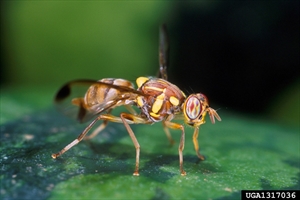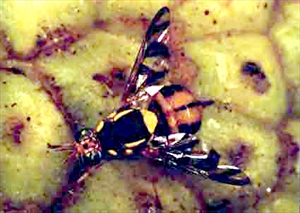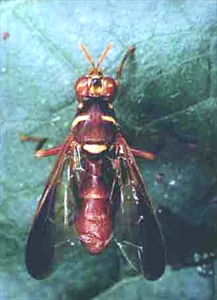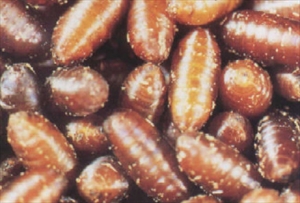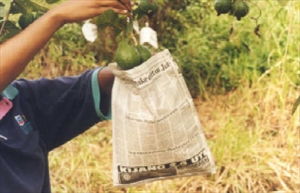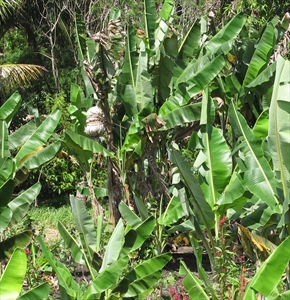- Bactrocera frauenfeldi - avocado, breadfruit, citrus, capsicum, carambola, guava, jackfruit, Malay apple, mango, papaya, plantain, soursop, and more; B. solomonensis - cucurbits; B. cucurbitae - cucurbits; B. umbrosa - breadfruit and jackfruit.
- Females need protein to lay viable eggs.
- Cultural control: bag fruit with paper or leaves; collect fallen fruit and destroy; harvest early (banana and papaya); some non-hosts, e.g., chilli, pineapple.
- Chemical control: use a commercial protein bait spray, e.g. MPPIL, Royal Tongalure or Bactrogel.
Pacific Pests, Pathogens and Weeds - Online edition
Pacific Pests, Pathogens, Weeds & Pesticides
Solomon Islands fruit flies (021)
Breadfruit fly, mango fly, melon fly, Solomon fly
Mango fly (Bactrocera frauenfeldi) (Photo 1); melon fly [Zeugodacus (Bactrocera) cucurbitae)] (Photo 2); breadfruit fly (Bactrocera umbrosa) (Photo 3); Solomon fly (Dacus solomonensis ) (Photo 4). There are many more fruit fly species in Solomon Islands, but these are pests of economic importance.
AUTHORS Helen Tsatsia & Grahame Jackson
Information (and photos 1,3-9) Leblanc L (2000) Fruit flies in Solomon Islands, SPC Pest Advisory Leaflet 30 (https://lrd.spc.int/pest-advisory-leaflet?start=10); and from Allwood A et al. (Fruit fly control methods for Pacific island countries and territories (2001), SPC Pest Advisory Leaflet 40. SPC, Noumea, New Caledonia. (https://lrd.spc.int/pubs/cat_view/469-pest-advisory-leaflets). Photo 2 Scott Bauer, USDA Agricultural Research Service, Bugwood.org.
Produced with support from the Australian Centre for International Agricultural Research under project PC/2010/090: Strengthening integrated crop management research in the Pacific Islands in support of sustainable intensification of high-value crop production, implemented by the University of Queensland and the Secretariat of the Pacific Community.

